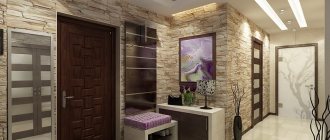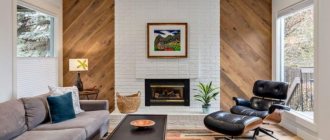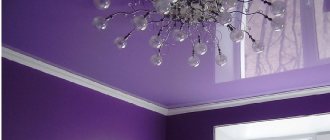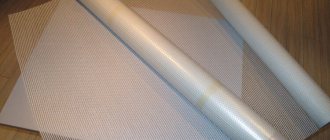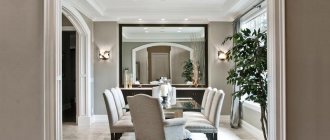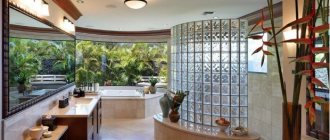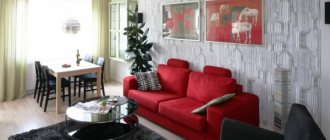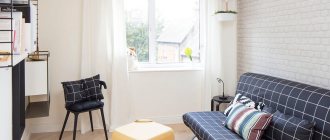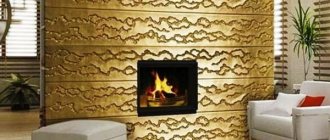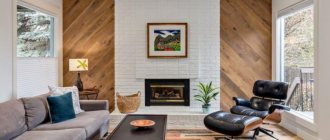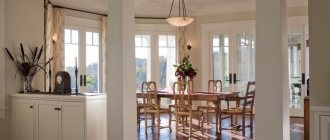Laminate for wall decoration has long won its rightful place as a relatively inexpensive and stylish material. Even laminate from the most inexpensive model range can be used for the job, and the result will create a feeling of respectable finishing with natural materials.
In addition, this material has a very wide palette of colors and textures, allowing for almost any design solutions.
It is important that the absence of any mechanical loads on the material attached to the wall makes this coating able to maintain an attractive and fresh appearance for a long time.
What is laminate?
Laminate is considered a floor covering that has proven itself well. The material consists of 4 layers:
- A substrate, which can be chipboard or solid wood.
- The pressed paper is impregnated with a special mixture, which makes it waterproof.
- The decorative layer is also paper, but has a characteristic embossing and color. This is the main layer that determines the appearance of the material.
- The protective layer is lamination. It is transparent and reliably protects the decorative layer from damage.
Laminate flooring at the head of the bed is an original decoration for the bedroom.
Eco-friendly bedroom with beautiful brown laminate wall
Even the smallest class 21 laminate can be installed on a bedroom wall. Since this room will not be subject to strong mechanical and thermal influences.
Features of the material
Currently, designers are increasingly choosing flooring materials as finishing materials. Laminate flooring for walls in corridors today is often installed in apartments and private houses. This is an interesting option that offers many design possibilities.
Laminate flooring is now available in a variety of colors and textures, as well as many other properties. It can give your living room a unique and interesting look. Before starting work, familiarize yourself with the main features of the material. This is necessary in order to avoid mistakes.
You can experiment. You can choose different types of laminate or cover the surface with panels of the same type. Layout patterns may also vary. The choice depends only on the preferences of the home owner. In addition to natural wood, laminate can imitate many other coatings.
This could be stone, leather or other decorative surfaces.
Advantage of finishing
Pamel is durable - you can hit it on a surface, and it does not leave marks.
The finishing material does not absorb moisture - its structure is quite dense, without pores. In addition, during the production process, the slabs are covered with an additional protective layer.
It does not require special care - a simple detergent is enough. But don't overdo it, because it's best not to leave the surface too wet and soapy.
Although the material is made from inorganic raw materials, this does not affect its environmental friendliness.
It's easy to install - you can even make it yourself.
Flaws
flaws:
- the cost is higher than for panels;
- due to the heavy weight of the material, it requires a stable substrate and reliable fastening;
- suitable for finishing rooms with constant low humidity levels; the material does not tolerate temperature changes.
Characteristics
Panels covered with laminating film consist of layers:
- The bottom one is made of cellulose. Plays the role of sound and heat insulation.
- Middle – basic. Made from MDF, chipboard, PVC, plastic.
- The top one looks like natural veneer or textured paper.
- Laminating film - completes the multilayer structure. Made from acrylic varnish.
The panel shapes are:
- Slats are boards with tongue-and-groove fasteners. They resemble a clapboard.
- Sheets have the largest dimensions, reaching up to 3 m2.
- The slabs are squares with a side length of 0.5-1 m.
Color combinations
Before you start finishing work, think about future moves and the color palette of the room. Neutral tones pair best with wood trim. However, even bright colors can go well with laminated walls.
Yellow
Another combination that exudes warmth and naturalness. Here you can go two ways - create contrast, for example, using an industrial concrete ceiling, or create a warm and natural interior. In the first case, a lemon-yellow shade and a laminate with a gray-beige texture are suitable.
For the second - mustard, honey for accent walls and curtains and chocolate-colored wood. Both have the right to exist in modern styles.
Red color
Fiery red color is quite active, attracts attention and creates an accent. Therefore, choose a floor of very calm shades.
In the kitchen, this could be a laminate flooring that imitates natural wood, a warm brown color that echoes the table, chairs and floor of a similar shade. Add a casual accent with pendant lamps above the table and an original poster.
In the bedroom, red should be used sparingly. Use white as a base and then add some red and gray elements such as laminate flooring and pillows.
Green color
The texture of wood with greenery is ideal for eco-style. Choose a laminate with a pattern that is as close as possible to natural wood, this is the only way you can achieve the desired effect. Let the light in - hang light curtains or beige blinds on the window and fill the room with the charm of enchanting white.
When it comes to decor, everything is very simple. Animal images on posters, pillows, photographs, along with a large bouquet of wildflowers or indoor plants can create the feeling that you are in a wooden house surrounded by a beautiful forest or meadow.
White color
Shades of white combined with wood create a perfect, light and airy duet. The interior looks very natural and clean.
Depending on your wishes, select the temperature of the color combination. This can be a warm color scheme - use milky colors in combination with light wood. This design will fit perfectly into a Scandinavian-style room.
Or you can go the other way - rely on unavailable white and wood colors with a gray undertone. If you want to decorate your bedroom this way, be sure to add soft, textured fabrics to make the room feel cozier.
Directions for board placement
Is the direction of laying laminate important or not? Similar to a natural board, this material can influence our perception of a room.
Not only the height of the walls and the square footage of the room, this can be significantly changed.
Diagonal arrangement
This approach allows you to lay laminate flooring in any room. This is a tedious and uneconomical method as it requires precise calculations and cutting the material at an angle.
Only a master with sufficient experience can lay laminate flooring beautifully. This method is rarely used in decoration.
Horizontal and vertical installation
Horizontal method. The joints form a single line, which should be covered with a plinth and secured to the wall with a dowel. Skirting boards should be located at a distance of no more than 1.5 m from each other. To make the floor durable and distribute the load evenly, cut the laminate into strips before starting work.
When laying slabs horizontally in the interior (as in the photo), the room will appear wider, and when installed vertically, it will appear taller.
Vertical method. Laminate flooring on the wall is laid vertically on a flat surface using glue; there are many layout options; you can combine leftovers from different batches and colors to create a unique interior design.
Decoration and decoration of walls
You can make wall decorations yourself or have a professional do it for you. It's your choice, we just have some ideas on how to do it.
Black and white
The classics of the genre are white decorative plaster or matte wallpaper and black laminate. This combination is always winning. The floor can be lined with long-pile fabric, and the headboard can be upholstered in leather. There are many possible combinations, but if you want to choose white laminate flooring for your bedroom, then black or dark brown will suit you.
An interesting option is to lay long sections of laminate vertically, so that there is a gap between them. The material should preferably be light, but the walls should be darker. If you place the spotlight correctly, the effect will be amazing.
Black will highlight, creating an even flow of light on black fabric, while white will give a cool and balanced effect.
A highlight in the light
Lighting can be varied. There are several popular options:
Installing classic lighting away from the wall where the laminate is laid. This is especially important when using non-solid materials. In the case of a solid pastel color, wall sconces installed in pairs are suitable.
A wall light can resemble a lamp or a candle. Another option is spotlights placed horizontally at the edge of the ceiling.
If the laminate is laid on a recess, then the spotlight is placed vertically on both sides of the recess. Such lighting will attract attention and optically enlarge the bedroom, creating a feeling of spaciousness and comfort.
One wall
What types of bedroom designs are suitable for laying single-color laminate flooring on an entire wall:
- predominance of one color;
- Maximum three colors;
- Avoid installing large chandeliers close to the wall;
- The main wall design should contrast with the shade of the laminate (dark-light or light-light);
- the ceiling and wall selected can be the same as the floor and wall;
- The smallest wall or the wall adjacent to the head of the bed is usually finished with laminate.
If you decide to highlight only one part of the room, it is best to start from the top. Ceiling plinths are not used.
Decorative vinyl laminate
Vinyl (PVC) is an excellent decorative material that can be laid on the surface of absolutely any room. It is moisture resistant and self-adhesive.
Panel
To add variety to the design, you can make a wall panel from laminate. You can play with colors. The panels can be laid lengthwise or crosswise.
Behind the sofa
The wall behind the sofa can be accented with laminate. It is ideal for accentuating a room and making it the main point of interest.
Ideas for using laminate flooring in various styles
There are a surprising number of ways to use laminate flooring in a variety of styles:
If a country style is required, a darker texture is chosen. Preferred are imitation logs, boards with a clear wood texture, natural beams
If the room is dominated by high-tech style, then pay attention to options made of glossy materials.
For modern classics, the most suitable material is imitation of light noble wood.
For an eclectic style, you can use different textures and the most unexpected shades. It is important to be organic and not overdo it with show.
Functionalism. The complete opposite of minimalism.
A combination of different elements from several interior design styles and a wide variety of decorative elements.
Bright and laconic living room interior in Scandinavian style.
- In a room decorated in the style of a Swiss chalet, laminate flooring with imitation walnut and ash will look good. If preference is given to a pleasant, sophisticated Provence style, then light, unobtrusive colors are needed, for example, bleached oak.
- Japanese style is characterized by muted accents that help emphasize the minimalism of the overall interior design, elegance and restraint. There should be no more than three shades. The preferred color is grey.
The color and texture of natural wood in the interior will transform any room.
The pop art style, which tends toward maximalism, dynamism, and boldness, allows you to pay attention to the laminate with green splashes on a blue background. This material will go well with the colorful designs of creative furniture.
If the interior is avant-garde, you can use rich shades in wall decoration. Achromatic black and white options also work well.
For a modern style, you can use beige or mustard tones. You can also use imitation plants.
Modern Art Deco interiors are characterized by sinuous lines, so choose laminate flooring with a similar pattern.
Eco-style is popular among people of all ages and interests. Natural materials, living plants and flowers calm the bustle of the city.
Mediterranean style interior design accents are combined with matching blue and purple tones. Modeling of gravel and sand is also possible.
Laminate in the interior - fashionable and practical
Thanks to the unique design qualities of laminate, it can harmoniously fit into the walls of any room if you choose the right shade and fastening.
A laminate wall becomes an accent in any room and attracts a lot of attention.
Living room
Any room can be transformed thanks to the simplicity and cost-effectiveness of laminate flooring. As in any room, you can use inlay to create an accent wall or small area. If your apartment has a modest living room, panels in light wood tones will help to optically enlarge it.
If you use your imagination, you can use several different types of panels, both in color and texture. This will make the design more complex and interesting. Typically, laminate is used for the TV area or the main sofa in the living room.
Kitchen
Laminate on the wall in the kitchen interior can be used as an accent wall and an apron on the countertop, which will protect against splashes and is easy to keep clean. The color should match the kitchen facades. To highlight the dining area, you can make a dark wood laminate wall.
Children's
With the help of light panels decorated with wood, you will give the property of young owners more light and warmth.
They also help tone the space. You can secure them in the crib area or designate an area for play or work. Since children love bright colors, laminate flooring with colorful inserts and prints will also help decorate the room.
In general, the texture and shade of the material for this room varies greatly, and how it looks depends on the overall design concept and the chosen color scheme.
Hallway and corridor
For the hallway, choose panels that differ from the color of the floor. The ideal choice should be a light or medium shade of wood, which will make the interior look warm and cozy. If you want to make dark walls, make sure that they are combined with large mirrors so as not to “steal” precious meters of the already narrow space.
For the same reason, you can use glued laminate, fixed directly to the concrete floor. A great idea is to build a recess for a small seating area, a shelf for shoes or a bicycle.
Bedroom
Laminate on a bedroom wall can be used as an insert above the head of the bed. If the bedroom is large, you can cover the entire wall with laminate and whitewash it, hang colorful accessories and framed photographs. A laminated wall at the headboard in the color of the bed will create a cozy atmosphere.
The photo shows an example of an interior with walls and floors finished in the same color. It looks impressive and creates a sense of timelessness.
Bathroom and toilet
Unfortunately, people still don't take laminate seriously as a material that can be used in areas with extreme temperatures.
The high level of humidity in bathrooms causes justified skepticism - and in vain, because in any hardware store you can always find a waterproof laminate floor that will serve faithfully for many years and delight the eye with perfect harmony with the rest of the interior.
Decorating a balcony or loggia
Laminate floors have become a standard element of the interior of balconies. It protects the wall insulation from moisture and can be used for balcony shelves and enclosing balcony cabinets. This is a great option if you are using it as an office.
Laminate flooring in rooms with panoramic windows
Large panoramic windows should not be framed with laminate - such finishing is best placed on the wall. For rooms with panoramic windows, you should choose brown panels that look like natural wood.
Laminate on the walls can be used if the bedroom has painted or glossy doors and large metal objects.
Glass or mirrors should not be placed next to or in front of a pamellato wall, and it is also not recommended to place this type of decoration in front of a panoramic window. Reflections in glass or glossy surfaces will reduce the beauty of accents in the interior. It is also better to decorate the ceiling in a bedroom with panoramic windows with a matte canvas.
How to make your interior look expensive
There are many ways to use laminate flooring to give a room a special shine and elegance.
Accent wall in dark colors
For a bedroom, for example, this could be a combination of warm shades of materials with soft lighting. Cold light in this case will reduce the cost of design and reduce its attractiveness.
For the living room, laminate flooring in dark and grayish tones can create a sensation among guests. Sophistication in this case should be emphasized by an overall calm color scheme in cool tones.
Creating infinite space
The wall, which is decorated with laminate, becomes the most noticeable in the room.
Therefore, you need to pay attention to those objects and furniture that will be located in close proximity. There simply shouldn’t be anything bulky, heavy or sloppy here.
We definitely pay attention to furniture and decor
The more open a wooden wall is to view, the more impressive it will look.
Types of laminate
Laminates vary in abrasion resistance class and pattern, as well as in the type and texture of the surface of the top layer on the panels. It is important to choose the right option for each floor. There is no universal solution for all interiors and premises.
By surface type
Laminate planks, depending on the number of “boards” in the lamellas, are divided into:
- one lane;
- two stripes
- with three stripes;
- multi-band;
- tile (stone).
There is no direct relationship between the number of stripes and the width of the plate. It all depends on the idea of the designer of a particular collection.
Laminate floor structure
Wide single-lane strips work best in large open spaces. Laying a laminate with such a structure more than 20 centimeters wide in a room of 10-15 square meters is not recommended. It will not look good on such a floor, especially if it is filled with furniture.
Planks with three or more stripes resemble narrow parquet boards of different shades. They are ideal for small rooms and corridors. Their two-way counterparts are a versatile choice for medium-sized living rooms, bedrooms and kitchens.
By design and surface structure
The texture of the surface layer of the laminate can be different:
- Classic - matte wood feel and lacquered finish;
- Corrugated - imitation of wood texture with a relief surface;
- Glossy, semi-gloss and matte (with wax coating);
- With or without chamfer.
If you want something natural and authentic, grooved laminate is the way to go. The texture of the wood on it is not only visible in all its glory, but also felt by bare feet and hands.
The choice between glossy and matte surfaces is more a matter of personal preference for the homeowner. Some people love gloss and shine in their interiors, while others definitely don't like it.
The beveled edge gives the laminate planks the appearance of massive parquet planks. This makes the floor look more chic and interesting than a simple beveled version.
If you are laying laminate on a base that is not perfectly level, it is better to choose a laminate with a chamfer along the entire perimeter of the board. This way, unevenness will be less noticeable.
By wear resistance class
Depending on the strength and degree of abrasion resistance, laminated boards are divided into several quality classes, which can be identified by markings.
Numbers 21-23 indicate that these products are intended for use in low traffic residential areas.
Classes 31-33 indicate the high level of abrasion resistance offered by laminate floors for use in public buildings and high-density apartments. This is the most durable floor covering and is usually purchased as a topcoat.
In the case of wall cladding, it makes sense to save money, since the load on such finishing is much lower. As a result, class 21-23 is best suited, and if such a product is not available, you can choose boards with a protection degree of 31.
Boards of domestic or European production are considered the most reliable. However, it is better not to buy Chinese ones, as they contain a high content of harmful substances. Good quality lining from the USA, but too expensive.
Advantages of laminated wall panels
It’s not for nothing that laminated wall panels have gained such popularity in such a short time. They have a lot of advantages. For example:
- Low cost. If you compare natural wood or stone, the price of the products is much lower. But despite this, they are able to imitate even this structure. And if nothing is lost in terms of aesthetics, then money can be saved.
- A large assortment of products differing in a range of colors, textures and patterns. Thanks to one of the layers, you can achieve an imitation of any natural material, choose the color and any structure.
- Excellent functionality. Laminated panels are used to decorate walls, floors, and ceilings; they are mounted in a horizontal or vertical position, and it is also possible to combine products with others.
- Easy to install. Even an amateur construction worker, not a professional, can handle the job. In addition, there are several installation options.
- Practical and easy to care for. The material is not afraid of moisture, it can be wiped with a damp cloth to remove dirt. And with proper care, the panels will last more than 10 years.
Much depends on the type of laminated panels. Since the basis for the material varies, the characteristics of the products vary somewhat.
Laminate types
Laying laminate on walls is carried out in several ways, depending on the type of material.
Sheet pile
For this method, a laminate with a tongue and groove connection is suitable, which connects the panels to each other. No glue is used and joints must be clean and dry. The slats are connected to each other using tongues and grooves, similar to slatted panels.
The panels are fixed to a special wooden sheathing installed earlier. For this, small nails or staples (paper clips) are used. The latter can even support laminate panels on a metal backing.
Tongue and groove laminate is often used as wall finishing
Clicky
This is a modern laminate of improved quality with an improved locking mechanism. The installation principle is similar to that of tongue and groove installation. When assembled, the panels are tilted approximately 20°, aligned and snapped into place. To ensure that adjacent panels are pressed tightly, they should be lightly pressed against each other.
Glue and small nails are used to attach the panels to the wood structure.
This type of laminate is more modern and easier to use. Buy laminate in small, low-density panels. Such panels will be easy to install.
Adhesive
These panels do not have special locks, and after fixing, the slats are connected by edges next to each other. Finishing requires a flat surface, since even small errors will lead to installation errors. Laminate floors are attached using liquid nails or special glue.
The reverse side of the slab is stitched with a zigzag stitch, then applied to the wall and pressed. Removing stripes can be difficult and panels do not always remain intact. Sometimes the wall surface itself can be damaged.
The most common laminate flooring is a flexible vinyl laminate with an adhesive backing.
Installation of laminate with glue or screws
A vacuum cleaner is used to clean the wall surface, then a primer is applied to the base. If the walls are made of wood, laminate boards are attached with self-tapping screws. Otherwise, if cement plaster is used, adhesive is applied. Thermal insulating material can be used as a primer; it will perform a shock-absorbing function and hide irregularities.
Information! Laminate can be glued if the wall surface is sufficiently smooth.
The weight of laminate flooring should not be underestimated, so after pouring, underlayment should be applied to the wall to ensure better adhesion between the adhesive and the laminate flooring. It is important to give the glue time to weather so that it has time to “set”; if this is not done, the panels may move under the weight of the upper rows.
Selecting Additional Items
It is very important to make the right choice of fasteners; the overall condition of the structure will depend on it. To fix the panels, clamps are usually used, which are inserted into the groove. When choosing them, it is necessary to take into account the thickness of the product being held - the thicker it is, the larger the diameter of the tongue should be.
Kleimer
Comparing clamps to other fastening materials, they cause less damage, whereas nails can split the board. Cleimers are available in two types: with a serrated tip and a flat one. The first one is driven into the panel with a tongue, and the second one presses the panel to the wall surface. Both elements are secured with small nails or screws.
Fastening with nails
When choosing liquid nails, it is necessary to consult what area of application they are designed for.
They are produced in two types: universal and for interior work. It is not recommended to cover walls made of dense laminate. That is why you should not use liquid nails to stick heavy objects. If the composition includes acrylic, then use at subzero temperatures is prohibited.
